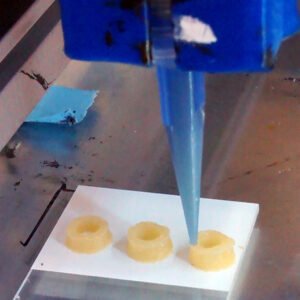Research
Nanoparticles in mollusk teeth lead to new ultrahard bio-inspired ink
May 31, 2021

Press highlights: New York Times, CNN, USA Today, Nature, Popular Science
Northwestern University researchers have, for the first time, discovered a rare mineral hidden inside the teeth of a chiton, a large mollusk found along rocky coastlines. Before this strange surprise, the iron mineral, called santabarbaraite, only had been documented in rocks.
The new finding helps understand how the whole chiton tooth — not just the ultrahard, durable cusp — is designed to endure chewing on rocks to feed. Based on minerals found in chiton teeth, the researchers developed a bio-inspired ink for 3D printing ultrahard, stiff and durable materials.
“This mineral has only been observed in geological specimens in very tiny amounts and has never before been seen in a biological context,” said Northwestern’s Derk Joester, the study’s senior author. “It has high water content, which makes it strong with low density. We think this might toughen the teeth without adding a lot of weight.”
The study will be published the week of May 31 in the Proceedings of the National Academy of Sciences.
Joester is an associate professor of materials science and engineering in Northwestern’s McCormick School of Engineering and an affiliated faculty member of the International Institute for Nanotechnology. Linus Stegbauer, a former postdoctoral fellow in Joester’s laboratory, is the paper’s first author. At Northwestern during the research, Stegbauer is now a principal investigator at the Institute of Interfacial Process Engineering and Plasma Technology of the University of Stuttgart in Germany.
One of the hardest known materials in nature, chiton teeth are attached to a soft, flexible, tongue-like radula, which scrapes over rocks to collect algae and other food. Having long studied chiton teeth, Joester and his team most recently turned to Cryptochiton stelleri, a giant, reddish-brown chiton that is sometimes affectionately referred to as the “wandering meatloaf.”
To examine a tooth from Cryptochiton stelleri, Joester’s team collaborated with Ercan Alp, a senior scientist at Argonne National Laboratory’s Advanced Photon Source, to use the facility’s synchrotron Mössbauer spectroscopy as well as with Paul Smeets to use transmission electron microscopy at the Northwestern University Atomic and Nanoscale Characterization and Experiment (NUANCE) Center. They found santabarbaraite dispersed throughout the chiton’s upper stylus, a long, hollow structure that connects the head of the tooth to the flexible radula membrane.
“The stylus is like the root of a human tooth, which connects the cusp of our tooth to our jaw,” Joester said. “It’s a tough material composed of extremely small nanoparticles in a fibrous matrix made of biomacromolecules, similar to bones in our body.”

Joester’s group challenged itself to recreate this material in an ink designed for 3D printing. Stegbauer developed a reactive ink comprising iron and phosphate ions mixed into a biopolymer derived from the chitin. Along with Shay Wallace, a Northwestern graduate student in Mark Hersam’s laboratory, Stegbauer found that the ink printed well when mixed immediately before printing.
“As the nanoparticles form in the biopolymer, it gets stronger and more viscous. This mixture can then be easily used for printing. Subsequent drying in air leads to the hard and stiff final material,” Joester said.
Joester believes we can continue to learn from and develop materials inspired by the chiton’s stylus, which connects ultra-hard teeth to a soft radula.
“We’ve been fascinated by the chiton for a long time,” he said. “Mechanical structures are only as good as their weakest link, so it’s interesting to learn how the chiton solves the engineering problem of how to connect its ultrahard tooth to a soft underlying structure. This remains a significant challenge in modern manufacturing, so we look to organisms like the chiton to understand how this is done in nature, which has had a couple hundred million years of lead time to develop.”
The study, “Persistent polyamorphism in the chiton tooth: From a new biomaterial to inks for additive manufacturing,” was supported by the National Science Foundation (award numbers DMR-1508399 and DMR-1905982), National Institutes of Health (award number NIH-DE026952), Air Force Research Laboratory (award number FA8650-15-2-5518) and Deutsche Forschungsgemeinschaft (award number STE2689/1-1).